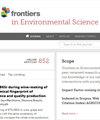Time series monitoring and analysis of Pakistan’s mangrove using Sentinel-2 data
IF 3.3
3区 环境科学与生态学
Q2 ENVIRONMENTAL SCIENCES
引用次数: 0
Abstract
Sustainable Development Goal-14 (SDG-14) directly demands the protection, conservation, restoration, and sustainable management of the global mangrove ecosystem. Assessment of the development Pakistan has made toward the sustainable management of mangrove ecosystems necessitates the remote sensing-based evaluation of national-level mangrove cover. Using Google Earth Engine (GEE) for geoprocessing 12,000+ 10-m high-spatial resolution Sentinel-2 time-series images (2016–23) and applying random forest (RF) classifier, the current research provides the latest spatial distribution of mangroves along Pakistan’s coastline and changes observed for a duration of 8 years. Additionally, this research provides the first spatiotemporal health assessment of Pakistan’s national mangrove cover as well. Rational analysis of the results indicated splitting the entire timeline based on two seasons (Jan–Jun and Jul–Dec). Results revealed an overall increase of 1,210 km利用哨兵-2 数据对巴基斯坦红树林进行时间序列监测和分析
可持续发展目标-14(SDG-14)直接要求保护、养护、恢复和可持续管理全球红树林生态系统。要评估巴基斯坦在红树林生态系统可持续管理方面取得的发展,就必须对国家级红树林覆盖率进行遥感评估。本研究利用谷歌地球引擎(GEE)对 12,000 多张 10 米高空间分辨率哨兵-2 时间序列图像(2016-23 年)进行地理处理,并应用随机森林(RF)分类器,提供了巴基斯坦海岸线红树林的最新空间分布情况以及 8 年间观察到的变化。此外,本研究还首次对巴基斯坦全国红树林覆盖情况进行了时空健康评估。对结果进行的合理分析表明,整个时间线以两个季节(1 月至 6 月和 7 月至 12 月)为基础进行分割。结果显示,全国红树林覆盖面积总体上将增加 1210 平方公里(2023 年);与 2016 年(1186 平方公里)相比,年均增加 3.42 平方公里。根据土地利用、土地覆被 (LULC) 过渡矩阵进行的红树林增减评估表明,红树林面积增加了 223 平方公里,减少了 199 平方公里;净增 24 平方公里。最大值和平均值-NDVI(2016-23 年)分别下降了 20.28% 和 7.91%,表明红树林的健康状况正在恶化。同样,显着的森氏斜率分析(p &p;lt;0.05)表明,在所有红树林-NDVI 像素中,88.8%的像素总体上呈下降趋势,而 11.2%的像素总体上呈上升趋势(2016-23 年)。结论是,尽管巴基斯坦的红树林覆盖范围有所扩大,但其健康状况却有所下降,这主要是由于为城市运营和海平面上升而砍伐森林造成的,红树林仍然很脆弱,有可能导致生态系统混乱,包括向大气中释放碳。这项研究将有助于制定红树林保护和管理策略,而未来的研究则可以探索陆地表面温度(LST)和蒸发蒸腾作用与 NDVI 相结合的潜力,以深入分析红树林的健康状况。
本文章由计算机程序翻译,如有差异,请以英文原文为准。
求助全文
约1分钟内获得全文
求助全文
来源期刊

Frontiers in Environmental Science
Environmental Science-General Environmental Science
CiteScore
4.50
自引率
8.70%
发文量
2276
审稿时长
12 weeks
期刊介绍:
Our natural world is experiencing a state of rapid change unprecedented in the presence of humans. The changes affect virtually all physical, chemical and biological systems on Earth. The interaction of these systems leads to tipping points, feedbacks and amplification of effects. In virtually all cases, the causes of environmental change can be traced to human activity through either direct interventions as a consequence of pollution, or through global warming from greenhouse case emissions. Well-formulated and internationally-relevant policies to mitigate the change, or adapt to the consequences, that will ensure our ability to thrive in the coming decades are badly needed. Without proper understanding of the processes involved, and deep understanding of the likely impacts of bad decisions or inaction, the security of food, water and energy is a risk. Left unchecked shortages of these basic commodities will lead to migration, global geopolitical tension and conflict. This represents the major challenge of our time. We are the first generation to appreciate the problem and we will be judged in future by our ability to determine and take the action necessary. Appropriate knowledge of the condition of our natural world, appreciation of the changes occurring, and predictions of how the future will develop are requisite to the definition and implementation of solutions.
Frontiers in Environmental Science publishes research at the cutting edge of knowledge of our natural world and its various intersections with society. It bridges between the identification and measurement of change, comprehension of the processes responsible, and the measures needed to reduce their impact. Its aim is to assist the formulation of policies, by offering sound scientific evidence on environmental science, that will lead to a more inhabitable and sustainable world for the generations to come.
 求助内容:
求助内容: 应助结果提醒方式:
应助结果提醒方式:


